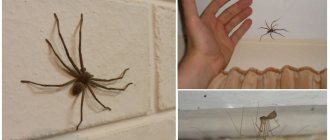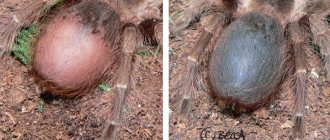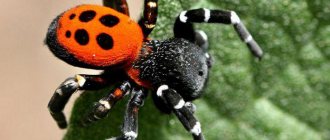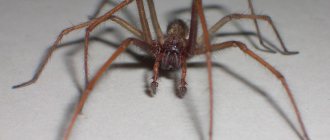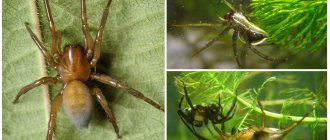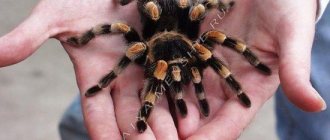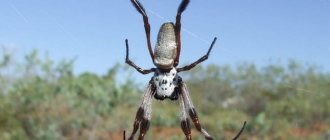The fauna of our planet is full of a huge number of living creatures that fascinate with their diversity, so it is often difficult to immediately determine what species an organism belongs to.
For example, not many people know that spiders belong to animals, a phylum of arthropods and a class of arachnids . There are more than 42 thousand species of spiders, of which 1.1 thousand are fossils.
Moreover, they can be found everywhere, even where no living creature can live. This article will take a detailed look at who spiders are and what they are.
Description of the spider
The spider is the most ancient creature on the planet. It is much older than humans; these organisms arose in advance. The remains of vital activity, spider webs, were discovered in the structure of amber, which is 100 million years old.
Arachnids lived on the globe back in the Paleozoic era, and this was 2.5 billion years ago. During this period, these creatures practically did not change in appearance.
To understand who spiders are, it is worth considering their features and description of their appearance. They have 6 pairs of limbs. However, the person notices 4 pairs. This is due to the fact that the first 4 limbs are transformed into organs of nutrition and touch.
General characteristics include the following appearance criteria:
- The body of arthropods is divided into two parts - the cephalothorax and abdomen. They are connected using a short jumper;
- the cephalothorax is divided by a groove into the head and thoracic parts;
- on the chest part there are the limbs of the spider, due to which it moves and weaves a web;
- on the surface of the head there are two pairs of limbs, eyes and a mouth opening.
The number of eyes may vary. Most arthropods have 8 visual organs. But in individuals living in the darkness of caves, they may be absent.
Structural features
In the external and internal structure of Arachnids there are common features that unite all individuals into one class.
External
External anatomical features are the same for Arachnids from different families.
The main ones will be the following:
- The body consists of a cephalothorax and abdomen. Both parts are connected to each other by a thin stem. The cephalothorax has a clear boundary dividing the body into the head and chest. The first pair of limbs, called chelicerae, is attached to the first.
- Chelicerae serve to capture prey and have a movable claw at the end. In poisonous individuals, poison is released through it.
- The second pair of limbs is called pedipalps.
- There are eyes on the head, some of them are on the front, others on the side.
- Between the chelicerae there is a sucking type oral opening.
- Four pairs of limbs called walking legs are attached to the abdomen. They serve for the movement of the individual and are usually well developed.
- Each leg consists of seven parts and has a pointed claw at the end.
- The abdomen has an oval or rounded shape, and there is a genital opening on the lower part. In males it is slit-like, in females it is surrounded by a peculiar plate of chitin with a process.
The body of spiders is covered with hairs of varying lengths and stiffness. In many individuals, the hair cover extends to the limbs; the hairs are long and very thick.
Internal
The internal structure of Arachnids has its own characteristics.
The main ones will be the following:
- The respiratory organs of individuals are represented by tracheas and peculiar pulmonary sacs, resembling thin plates in structure. Oxygen enters them through the spiracles.
- The circulatory system of individuals is not closed. Blood passes through the vessels and also fills the gaps between organs. The heart is represented by a dorsal vessel located in the abdomen and shaped like a tube with three slit-like openings. The holes have valves.
- The digestive system of representatives of the order consists of the foregut, midgut and hindgut. The anterior one begins with the pharynx, smoothly turning into the stomach. The stomach contains glands that secrete enzymes for the rapid processing of proteins. Spiders have an organ in their abdomen that acts as a liver; it secretes enzymes and facilitates digestion. The hindgut ends in the rectal bladder.
- The nervous system of Arachnids is represented by two nerve ganglia located in the cephalothorax. Nerve endings extend from them to all organs and tissues.
- The sense organs are represented by the eyes, special hairs responsible for smell and touch. Spiders do not have ears or taste buds in the mouth; this function is also performed by hairs located on the limbs.
- The reproductive system is represented by openings on the lower part of the abdomen; paired gonads are located inside. All individuals of the order are dioecious, fertilization is internal.
Typically, spiders have pronounced sexual dimorphism, so it is easy to distinguish between female and male individuals. An additional organ for representatives of the order will be the spinning apparatus, with the help of which animals produce web threads.
Is a spider an insect or not?
Many people wonder whether a spider actually is an insect or an animal. Most will immediately answer that it is an insect, but this is not the case. Even if in appearance this organism looks like crawling small inhabitants, it is in no way related to them and has distinctive features.
They are animals; among the inhabitants of the fauna they are classified as invertebrates. These are arthropods that have jointed limbs, a hard chitinous cover, which is a hard exoskeleton.
Therefore, the question arises why spiders are not insects and animals. And also interested in what exactly connects mammals, what common features they have with insects and differences from them. This is worth considering carefully.
General signs
The family of spiders and insects share some common characteristics. This is due to the fact that arachnids belong to the class of arthropods.
They have the following characteristic qualities:
- creatures have a chitinous skeleton to which muscles are attached;
- the structure of the eye in arthropods is formed from many ocelli; it is often called facet;
- females reproduce by laying eggs.
Main differences
To understand what a spider is - an animal or an insect, it is worth carefully considering its main characteristics.
Many people mistakenly consider it an insect, but this is not so, and this is indicated by the following distinctive features:
- spiders have 8 legs, and insects have 2 fewer;
- Insects have 3 body segments, and arachnids have 2;
- spiders are able to weave webs;
- In nature, insects have a huge number of species and subspecies;
- arthropods produce poison, which is required for external digestion of food;
- unlike insects, arachnids do not have metamorphism (transformation) in their life cycle;
- The communication system and nervous system of insects is much more complex than that of arthropods.
Human use
Fried tarantula spiders are considered a delicacy in Cambodia
In Cambodia and among the Piaroa Indians of southern Venezuela, fried tarantula spiders are considered a delicacy. Before cooking the tarantula, its burning hairs are removed.
Tarantula spiders are also widely used as exotic pets.
The venom of most spiders, which is lethal to insects and harmless to vertebrates, pollutes the environment less and is therefore an alternative to conventional pesticides. Thus, Australian spiders from the family Atracinae
produce a poison against which most insect pests common on Earth have no immunity. These spiders thrive in captivity and easily produce poisonous “milk.” Spider genes responsible for the production of toxins can be introduced into the genome of viruses that infect certain types of crop pests using genetic engineering.
The possible medical uses of spider venom are being explored to treat cardiac arrhythmia, Alzheimer's disease, stroke and erectile dysfunction.
Since spider web (“spider silk”) has a beautiful shine, is very strong and wear-resistant, attempts are being made to produce it using genetic engineering from goat milk and from plant leaves. Transparent spider web fibers are used by physicists working on optical communication systems to produce a diffraction pattern in an interferogram in the N-slit interferometer.
Interesting facts about spiders
Unusual facts about spiders will amaze many who do not yet know about these creatures. But they conceal many mysteries, secrets, and have unique features that other organisms living on the globe do not have.
Let's look at 15 interesting facts about spiders:
- The web is not only a trap for insects, it is capable of deflecting several millimeters in order to grab and stick an insect to itself. This phenomenon is carried out due to a static charge, which appears during the flight of the insect.
- The bite of the Brazilian wandering spider is not always fatal, but it often causes impotence in men.
- With the help of its limbs, the spider can determine what has reached it in the web. But edible or inedible helps him establish the olfactory organs, which are located on his legs.
- The animal has a durable shell. Its strength can withstand a nuclear explosion.
- The web is very light. If you take a spider thread the length of the earth's equator, then its weight will be only 340 grams.
- Spider web is considered a powerful and durable material. If its thickness is increased to the thickness of a pencil, then such a web could stop a Boeing. In New Guinea, fishermen use this material to catch fish, and in South America there are spider web bridges that support monkeys.
- The lifespan of arthropods is 30 years. But they rarely die of old age.
- At one time, the female can lay up to 20 thousand eggs, from which spiders hatch.
- In nature, there are varieties of spiders that, after being born, eat their mother.
- There are varieties of arachnids in which the brain occupies the largest part of the body, so other organs are forced to be located on the legs. The smaller the spider, the larger its brain.
- In the Netherlands there are more spiders than people. For 15 million human population there are 5 thousand billion arthropods.
- In Cambodia, people enjoy eating tarantula spiders. They are also brought up at home, they learn to dance, and play willingly. And if necessary, they can protect the owner.
- There are types of spiders that do not weave webs - the jumping spider, the lynx spider. They do not catch prey with webs, but hunt it.
- Tarantulas can live without food for about two years.
- The gladiator got its name due to the fact that it weaves a web in a square. He does not leave her until the prey falls into her; he himself abruptly throws the net on her, thereby leaving no chance to escape.
Spiders - what are they: types
Researchers know about 42 thousand species of spiders. Spiders can be divided into three large suborders, which differ mainly in the structure of the jaws, or more precisely, in the position of the chelicerae relative to the longitudinal axis of the body.
Suborder Orthognatha
More often, representatives of this suborder are called migalomorphs. They are characterized by the presence of thick hairs, large sizes and a primitive structure of the jaws - the claw is directed downwards and grows only on the upper jaw. The respiratory system is represented by pulmonary sacs.
The majority of mygalomorphs live in warm climates. They make burrows underground.
Orthognatha includes:
- tarantula spiders
- funnel spiders
- ctenizidae
- digger spiders
Suborder Araneomorpha
Almost all other species of spiders known to naturalists belong to the large group Labidognatha or Araneomorpha. They differ in that both jaws are equipped with claws. The respiratory system is represented by the trachea.
Types of spiders that catch prey without a net:
- crab spiders
- jumping spiders
- wolf spiders
Types of spiders using a trapping net:
- linifid spiders
- web spiders
- funnel spiders, or house spiders
- long-legged spiders
- orb weaving spiders
Among the araneomorphic spiders, there are also those that are not capable of producing cribellum, the substance from which spiders produce strong web silk, and those that produce it.
Suborder Mesothelae
Lyphistiomorphic spiders are distinguished by the fact that the chelicerae are spread out to the side rather than pointing downwards. This position is considered more evolutionarily advanced. But this suborder is considered the most primitive; traces of it were found in Carboniferous deposits. Spiders have archaic pulmonary sacs and four pairs of arachnoid warts, which have not yet been moved to the end of the abdomen. They live in earthen burrows that are closed with a lid. Signal threads radiate from the minks. Although one species prefers caves, where it makes web tubes on the walls.
These include:
- arthropod spiders
- primitive arthrolycosid spiders
- primitive arthromigalid spiders
Species and subspecies
Answering the question of what kinds of spiders there are, it is worth noting that these creatures are divided into species and subspecies, which have some distinctive features.
In nature, there are about 35 thousand species of archanids or arachnids, which differ in appearance.
Different types of spiders have characteristic forms of life activity, which include reproduction, feeding habits, habitat in natural conditions, and size.
Characteristic features include:
- their body consists of two parts - the abdomen, which can have different shapes, it all depends on the type of arthropod, as well as the cephalothorax;
- characterized by the presence of 4 pairs of legs, 2 chelicerae and pelipalps;
- spiders do not have whiskers;
- the main feature of the creatures is to weave webs for various purposes, and its design may have some peculiarities;
- there are poisonous glands, the poison of which has a paralyzing effect on the victim;
- prefer to lead a solitary lifestyle. Most females, after fertilization, eat a select few.
It is impossible to know exactly how many spiders there are in the world, because there are many of them.
At one time, a female is capable of laying 15-20 thousand eggs, most of which hatch into spiders, so it is difficult to imagine how many dozens of females can lay and give birth at a time.
The classification combines many types. In nature, there are exotic representatives of arthropods that do not pose a danger to humans; they are preferred as pets.
It is worth paying attention to the dangerous and poisonous breeds of spiders; they inhabit the tropics and other hot areas, for example, deserts.
Types of spiders
The order of spiders includes approximately 46 thousand living and approximately 1.1 thousand extinct species. It includes two large suborders:
- Arthroplasty spiders, which belong to 1 family, including eight modern genera and four extinct ones.
- Suborder Opisthothelae, which includes araneomorphic spiders and tarantulas. The first of these infraorders includes 95 families and more than 43,000 species, and the second includes 16 families and more than 2,800 species.
The following spiders belonging to each of these suborders are of greatest interest:
- Lifistius. Distributed in Southeast Asia. The body length of females ranges from 9 to 30 mm; the males of this species, like most other spiders, are smaller. Like other arthroplasties, Liphistius has visual signs of segmentation on its abdomen. These spiders live in burrows at great depths, and their doors are round webs, which they skillfully camouflage with moss or earth. Liphistius are nocturnal: they spend their days in burrows, and at night, using signal threads, they hunt other invertebrates, such as woodlice or insects.
- Maratus volans. A species belonging to the family of jumping spiders, native to Australia. It is famous for the very bright colors of its abdomen, as well as for its unusual courtship ritual, when males (in fact, only they have bright colors, while females are painted in grayish-brown shades) seem to dance in front of the females. But those, if they don’t like the gentleman for some reason, without hesitation, can catch him and eat him.
- Goliath tarantula. The largest tarantula in the world. This inhabitant of South America lives in burrows lined with cobwebs on the inside. The body length of females of this species reaches 10 cm, and males - 8.5 cm. The leg span reaches 28 cm. The cephalothorax and abdomen are rounded and almost equal in size, the color of this spider is not particularly bright - brownish. The large size of this spider makes it very interesting for spider breeders. But the ban on exporting the Goliath spider from the places where it lives and the difficulty of obtaining offspring from it in captivity make it very rare as a pet.
In Australia, as well as in Florida and California, there is another amazing spider - the spiny orb. It is named so because its flat, brightly colored abdomen is equipped with six rather large spines, similar to the rays of stars. The color of this animal can be different: white, yellow, reddish or orange, and the size of the web made of cobwebs can reach 30 cm in diameter.
What order and class do spiders belong to?
If we talk about what class spiders belong to, then this is the class “arachnids”. It stands apart from all others, which is associated with the characteristic features of the body structure of arthropods.
They have it divided into two parts - the abdomen and the cephalothorax, but in representatives of other classes the body has a slightly different structure.
There is another characteristic difference - the number of legs. Arthropods have 8 of them instead of 6. They have chelicerae, which are located on the front of the cephalothorax.
They also have pedipalps, which look like tentacles. They are located on the sides of the body and perform the same functions as the paws.
These organisms belong to the order Spiders, the family Arthropods. Spiders are often called "archans", this name comes from the name of the suborder to which these creatures belong - Orthognatha.
It is distinguished by species diversity and specific appearance.
This suborder includes spiders called mygalomorphs. The body of representatives of this species is completely covered with short hairs. They prefer to live in dungeons.
The group includes the following species:
- tarantulas;
- ctenises;
- funnel spiders;
- diggers.
Kinds
There are individuals that live only in certain regions. Others are almost ubiquitous. However, most spiders are adapted to living under certain climatic conditions.
Which ones are there in Russia?
On the territory of the Russian Federation you can find many varieties of individuals from the order Spiders.
The most commonly found types are:
- Karakurt, or black widow, is a poisonous species common in Rostov, Volgograd and other regions of the country. It is small in size, painted black, red spots can be seen on the back of young creatures, the legs are long and thin. The animal's bite is deadly.
- The South Russian tarantula is one of the largest animals of the order, living in the Saratov, Oryol, Kursk and other regions. The individual is colored gray, brown, brown, and has a pattern on its abdomen. The body has thick hair. A tarantula bite is not fatal to humans, but causes severe discomfort. It attacks the victim from the hole.
- The tarantula spider usually lives in tropical climates, but in recent years they can be found in some regions of the Russian Federation. This is the largest creature of the order; the leg span can reach 30 cm. The color of the tarantula can have a greenish, bluish, purple tint, the body and legs are covered with hairs. In some individuals they are long and rigid. The animals are safe for humans and many keep them as pets.
- The cross is a common animal. In the regions of the Russian Federation there are about 30 different individuals of this family. The difference between this animal and others is that it always weaves a large web. Crossbills are active in the evening, hunt insects, and often climb into a person’s house. The bite of an individual is painful, but not fatal.
- Argiope Brünnich, or wasp spider, is an animal distinguished by its bright color, reminiscent of the well-known insect. Females are much larger than males. The latter are usually painted gray or brown. Argiope can live in the Eastern part of the Russian Federation.
- White karakurt is common in the Middle East. The abdomen of the individuals is round, white, the legs are black and long. Females are much larger than males. Animals are poisonous and dangerous to humans.
- Wolf spiders are often found in the Russian Federation. You can often find individuals in a house, cellar, front garden or garden beds. The size reaches 3 cm in the leg span, the color is gray, brown, black. The animal's bite is not dangerous, but painful, causing swelling and severe itching.
There are many more creatures of this order found in Russia, but most of them are safe for humans. Their numbers are growing as the country's climate changes, making it a good place for spiders to live.
Features of reproduction
During the process of active growth, spiders from time to time shed their tight shell, which consists of a chitinous structure. They gradually acquire a new, stronger one.
Over the entire period of their life, they can molt up to 10 times . Spiders are heterosexual individuals, with the female being much larger than the male.
The mating period lasts quite a long time, its season begins in mid-autumn and lasts until early spring. At this time, the male fills the bulbs, which are located at the ends of the pedipalps, with sperm, then he goes in search of the female.
After performing the “mating dance” and fertilization, the male leaves and dies in the subsequent period.
As soon as 2.5 months have passed, the female lays eggs. After 35 days, spiderlings hatch from them and live in the web until the first molt. Sexual maturity in females occurs at the age of 3-5 years.
What kingdom do spiders belong to?
Small creatures, which are often found in the wild, in your own home, apartment, attics, outbuildings, resemble all kinds of insects and beetles. Spiders and insects are often combined into one family due to their small size and similar lifestyle. However, in tropical countries. where arthropods up to 35 cm in size live, such associations practically do not arise.
There are 5 kingdoms in total - animals, plants, fungi, bacteria and viruses. Historically, spiders and insects belong to the same kingdom, phylum - animals, arthropods. Only the class or squad is different. Therefore, the question of whether a spider is an animal or an insect is fundamentally wrong. The animal is a kingdom, insects are a class.
Since everyone has long been accustomed to the fact that insects are insects, and animals are full-fledged mammals, confusion in concepts has arisen among ordinary people. Why the spider stands apart is explained by its unusual lifestyle and small size. In order not to seem uneducated, you need to clearly understand that a spider is not an insect.
Feeding spiders
The spider is considered a predatory creature by nature. Its diet mainly consists of insects, and it can sometimes catch small animals. The exception is the jumping spider; it prefers to eat only plant foods (grass, berries, leaves).
The arthropod hunts using nets that it skillfully weaves from cobwebs. In nature, there are varieties of these creatures that use web shots during hunting, while they hypnotize the prey, leaving it no chance to escape.
Despite the fact that they are considered obligate predators, catching prey on their own, they do not have teeth . To eat prey, they need to dissolve its tissues and make a nutritious broth from it.
For these purposes, spider venom is used; the animal injects it into the victim through hollow chelicerae. This allows you to achieve two goals - killing the prey and obtaining a nutrient solution.
Spiders and insects: representatives of the phylum arthropods
The differences between small creatures that have several pairs of legs are reflected in the classification adopted in zoology. Insects belong to the class of the same name called arthropods. Spiders belong to the class Arachnida and the same phylum as insects. You should know that arachnids include not only spiders, but also ticks and scorpions. But between these animals there is a significant difference in body structure and behavior.
Today there are more than forty thousand species of spiders on the planet. They can be found almost everywhere. Almost all spiders feed on other living organisms, such as insects. But the insects themselves can be seen in all corners of the Earth. And the number of their species that have been classified and described in science is about a million.
Of course, both arthropods differ from each other in the structure of their internal organs. But the structure of the organisms of these little ones is quite complex, so it will not be easy for a person who is not a specialist in the field of biology to understand the fundamental differences between a spider and, for example, an ant. Therefore, the most reliable way to determine who you met on a forest path is by characteristic external signs.
How are spiders similar to insects?
Most people, when asked what a spider is, answer - an insect. This is wrong. Then why are they considered the same creatures?
Spiders and insects are similar in that they belong to the same kingdom - animals. Animalia includes different species, but mammals, for example, have nothing in common with Insecta. But arachnids and insects have a number of similarities:
- both species belong to the multicellular animals of the bilateral group;
- develop and also reach maturity after a certain number of molts;
- have a chitinous exoskeleton;
- Representatives of both classes have small bodies limited to small areas around the reproductive and excretory systems;
- an open circulatory system in which a tubular heart pumps blood through the hemocole;
- the heart is located in the abdominal cavity.
Most arachnids and insects prefer countries with a warm, humid climate.
Is a spider a predator or a herbivore?
Arachnids hunt insects and regulate their numbers. Because some of the insects that make up the spider's food chain are beneficial, it is difficult to say whether it is beneficial or harmful to humans.
Predators eat their prey using their jaws, chewing the food thoroughly. As for the peaceful inhabitants of the planet, their main diet is nectar, which they obtain with the help of their proboscis.
There are spiders that hunt their own kind. They live in our homes, destroying their own relatives and insects over the winter. In difficult times they can kill their own children.
Arachnids have differences in diet.
- At the initial stage, as soon as the prey is caught, he injects gastric juice,
- Waits for some time until the soft tissues soften,
- Absorbs nutrients through a narrow mouth that does not have teeth, lips, or the usual mechanisms of the oral apparatus.
Almost all individuals are predators . There is only one peaceful inhabitant whose diet consists of plants - the Bagheera Kipling spider .
Is a spider classified as an insect and why? Spider refers to an animal or insect
Spiders in Latin are Araneae, Aranei. They belong to the animal kingdom, the phylum of arthropods, the class of arachnids. There are 42 thousand modern and about 1.1 thousand fossils in the world. They are widespread, inhabiting almost all continents of the globe. Obligate carnivores - feed on insects, small animals, and amphibians. An exception is Bagheera kiplingi, whose diet consists of the green part of the acacia tree. On the territory of Russia and the former CIS countries there are 2888 species. The science of spiders is called arachnology.
Arachnids live everywhere, some of them live in human apartments and utility rooms. Exotic, kept as a pet.
